Lauren Elizabeth Bats Page
When people think about bats, they often imagine things that are not true. Bats are not blind. They are neither rodents nor birds. They will not suck your blood -- and most do not have rabies.| www.richwooders.com | | Wildlife Index! | ||

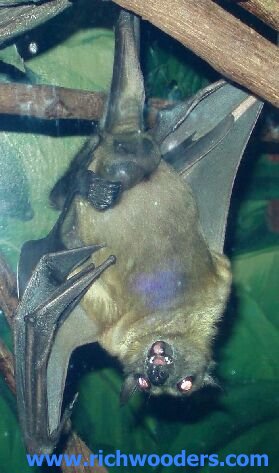
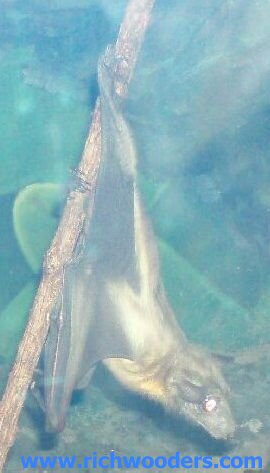
| Bats found in West Virginia | |||
| (1) Evening Bat (Nycticeius humeralis) | (2) Rafinesque's Big-eared Bat (Plecotus rafinesquii) | (3) The northern bat or northern Myotis (Myotis septentrionalis) | (4) Hoary Bat (Lasiurus cinereus) |
| (5) Silver-haired bats (Lasionycteris noctivagan) | (6) Eastern small footed bat (Myotis leibii) | (7) Gray Bat (Myotis grisescens) | (8) Red Bat Eastern Red Bat - (Lasiurus borealis) |
| (9) Eastern Pipistrelle Bat (Pipistrellus subflavus) | (10) Little brown bat also know as the Littlebrown Myotis (Myotis lucifugus) | (11) Big brown bat (Eptesicus fuscus) | (12) Virginia Big-eared Bat (Corynorhinus townsendii virginianus) |
| (13) Indiana bats (Myotis Sodalis) |
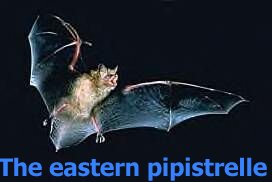
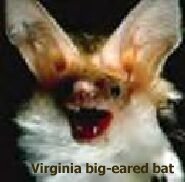
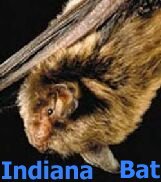
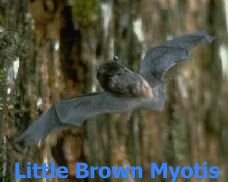
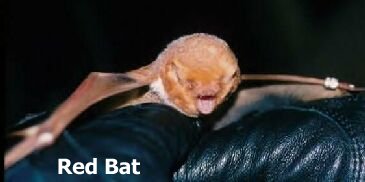
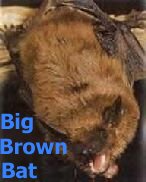
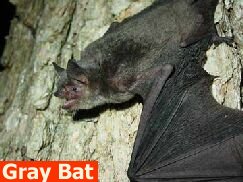
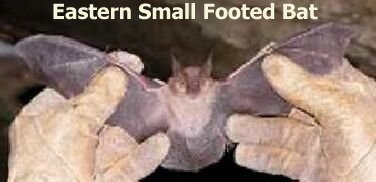
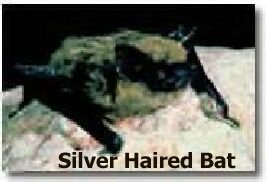
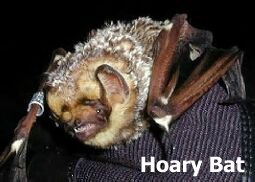
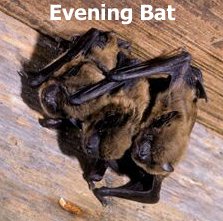
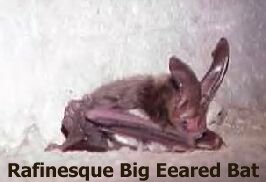
Feeding Habits:
The eastern pipistrelle is an insectivore, foraging along forest edges and open water. It’s diet consists mostly of moths (Fitzgerald et al., 1994).
Wintering habits:
The eastern pipistrelle hibernates in groups within caves or buildings (Caire et al., 1989).
Reproduction:
This bat mates in the fall, undergoes delayed fertilization, and generally gives birth to two offspring in June or July (Caire et al., 1989).
Physical traits:
This bat appears reddish-gold throughout most of its body. It’s coat is gray at the base and light yellow in the middle. The tips of it’s hairs are burnished brown. The ears are pinkish-brown and the membranes are black. The forearm is about 33mm long (Caire et al., 1989).
Best time of day and place to see it:
During summer, the eastern pipistrelle prefers to live in solitude among forest trees. During winter it can be found hibernating in groups within caves to keep warm. This cave is often shared by Townsends big-eared bats. When foraging, the eastern pipistrelle can be found flying along forest edges or open water. The fight patterns of this bat are fast and erratic (Caire et al., 1989).
The eastern pipistrelle bat is uncommon throughout West Virginia.
Eastern Red Bat - Lasiurus borealis: About twice the size of the eastern pipistrelle; only seen singly (and seems to hang in place until it dies); fur reddish to yellowish, frosted; white ruff under chin; ears rounded but lacking black margins and it is a uncommon bat in West Virginia.
Little brown bat also know as the littlebrown Myotis. Slightly larger than the eastern pipistrelle; may roost singly, in pairs, or in clusters of a dozen or more bats, likes attics in summer; fur medium to dark brown, glossy highlights; belly fur distinctly lighter than back fur; dark forearms with chocolate brown wing membrane; overall appearance of fur and membranes glossy; fur sometimes covered with condensation. The little brown bat (Myotis lucifugus) is one of the most common of the 13 bat species that occur in West Virginia.
Gray bat (endangered): About twice the size of the eastern pipistrelle; hibernates in very large numbers in only a few, vertical caves; forms looser clusters than Indiana bats but common habit of bats hanging upon other bats produces multiple layers in some clusters; frequently hangs with wings unfolded; fur uniform medium gray but bleaches to reddish by spring and early summer; summer colonies form in caves in river valleys or near lakes; makes large guano mounds in summer caves; highly vulnerable to disturbance during all seasons (arousal during hibernation causes depletion of fat reserves; disturbance of maternity colonies causes panic and may produce mortality of young).
The gray bat is an endangered species.
What is the Gray Bat?
Appearance
Gray bats are distinguished from other bats by the unicolored fur on their back. In addition, following their molt in July or August, gray bats have dark gray fur which often bleaches to a chestnut brown or russet. They weigh 7-16 grams. The bat's wing membrane connects to its ankle instead of at the toe, where it is connected in other species of Myotis.
Habitat
With rare exceptions, gray bats live in caves year-round. During the winter gray bats hibernate in deep, vertical caves. In the summer, they roost in caves which are scattered along rivers. These caves are in limestone karst areas of the southeastern United States. They do not use houses or barns.
Reproduction
Females give birth to a single young in late May or early June.
Feeding Habitats
The bats eat a variety of flying aquatic and terrestrial insects present along rivers or lakes.
Range
The gray bat occupies a limited geographic range in limestone karst areas of the southeastern United States. They are mainly found in Alabama, northern Arkansas, Kentucky, Missouri, and Tennessee. A few can be found in northwestern Florida, western Georgia, southeastern Kansas, southern Indiana, southern and southwestern Illinois, northeastern Oklahoma, northeastern Mississippi, western Virginia, West Virginia but only a few individuals gray bat have been reported, and possibly western North Carolina.
Why Is the Gray Bat Endangered?
(1) Human Disturbance
Gray bats are endangered largely because of their habit of living in very large numbers in only a few caves. As a result, they are extremely vulnerable to disturbance. Arousing bats while they are hibernating can cause them to use up a lot of energy, which lowers their energy reserves. If a bat runs out of reserves, it may leave the cave too soon and die. In June and July, when flightless young are present, human disturbance can lead to mortality as frightened females drop their young in the panic to flee from the intruder.
(2) Habitat Loss or Degradation
Many important caves were flooded and submerged by reservoirs. Other caves are in danger of natural flooding. Even if the bats escape the flood, they have difficulty finding a new cave that is suitable.
(3) Cave Commercialization and Improper Gating
The commercialization of caves drives bats away. Any gating on the cave that prevents access or alters the air flow, temperature, humidity, and amount of light is harmful.
What Is Being Done to Prevent Extinction of the Gray Bat?
(1) Listing The gray bat was added to the U.S. List of Endangered and Threatened Wildlife and Plants on April 28, 1976.
(2) Recovery Plan
The U.S. Fish and Wildlife Service has developed a recovery plan that describes actions needed to help the bat survive.
(3) Habitat Protection
A variety of government and private conservation agencies are all working to preserve gray bats and their caves.
The big brown bat (Eptesicus fuscus) is widely disturbed, and is the most abundant, commonly seen bat in North America. The big brown bat ranges from upper South America through the United States and into Canada. Big brown bats are even found in the Caribbean Islands. The mammal's ears and wings are always black, but the fur color varies geographically, with the stomach area always being paler. Females are larger than the males. The bats can be recognized in flight because they fly in straight lines at a height of 20-30 feet. Big brown bats mate in the fall and sperm is stored inside the female's body over the winter. After a 2 month gestation period, young are born in mid-summer. The newborns are naked and immobile, but mature quickly. Eyes and ears open within hours of birth, and juveniles can began foraging 3-4 weeks after birth. In Eastern North America, twins are common, but in other parts of their range only a single baby is born. Big brown bats begin hunting shortly after sundown and spend about 90 minutes a night foraging. On an average night, a big brown bat will consume 50-100% of its body mass in insects. The bats play an important part in keeping insects in some urban areas under control, eating at a rate of 5-20 insects a minute. Big brown bats dependency on insects made the use of DDT, as an insecticide, highly detrimental to them. Insects that had been affected by DDT were consumed by the bats, creating a build up of the chemical in the bats body. While big brown bats eat a wide variety of insects, they prefer to eat beetles. An adult brown bat will weigh 14-35 grams. Prior to hibernation up to 30% of the bats body weight is fat reserves. While big brown bats tend to forage separately, they do roost together. Roosting sites include dark buildings, such as attics, barns or bridges and trees. Big brown bats can be found hibernating in places such as buildings, caves, mines and houses. Colonies of up to 300 females have been recorded. The females will move roosting sites if they are disturbed. The bats use facial glands that secrete a musky odor to mark their roost and hibernation sites. The bats do not like hot temperatures and will move if it becomes warmer than 95° F. Cold temperatures seemed to be tolerated more easily with bats surviving subfreezing body temperatures. Some big brown bats have been known to live up to 19 years in the wild. The big brown bat (Eptesicus fuscus) likely to enter homes and is one of the most common of the 13 bat species that occur in West Virginia
Silver-haired bats (Lasionycteris noctivagan) are among the most common bats in forested areas of America, most closely associated with coniferous or mixed coniferous and deciduous forest types, especially in areas of Old Growth. They form maternity colonies almost exclusively in tree cavities or small hollows. And like many forest-roosting bats, silver-haired bats will switch roosts throughout the maternity season. Because silver-haired bats are dependent upon roosts in Old Growth areas, managing forests for diverse age structure and maintaining forested corridors are important to these bats. It is estimated that these bats require snag densities of at least 21 per hectare and often forest management practices have fallen far short of this figure. Unlike many bat species, silver-haired bats also appear to hibernate mainly in forested areas, though they may be making long migrations from their summer forest to a winter forest site. Typical hibernation roosts for this species include small tree hollows, beneath exfoliating bark, in wood piles, and in cliff faces. Occasionally silver-haired bats will hibernate in cave entrances, especially in northern regions of their range. Like big brown bats, the silver-haired bats have been documented to feed on many insects perceived as pest species to humans and/or agriculture and forestry. Even though they are highly dependent upon Old Growth forest areas for roosts, silver-haired bats feed predominantly in disturbed areas, sometimes at tree-top level, but often in small clearings and along roadways or water courses. Though their diets vary widely, these bats feed chiefly on small, soft-bodied insects. Silver-haired bats have been known to take flies, midges, leafhoppers, moths, mosquitoes, beetles, crane flies, lacewings, caddisflies, ants, crickets, and occasional spiders.
Hoary Bat - Lasiurus cinereus
Hoary bats are one of America's largest and most handsome bats. With their long, dense, white-tipped fur, they have a frosted, or hoary, appearance. Humans rarely get the chance to see these magnificent bats; they are not attracted to houses or other human structures, and they stay well-hidden in foliage throughout the day. They typically roost 10-15 feet up in trees along forest borders. In the summer, hoary bats don't emerge to feed until after dark, but during migration, they may be seen soon after sundown. They sometimes make round trips of up to 24 miles on the first foraging flight of the night, then make several shorter trips, returning to the day roost about an hour before sunrise. Between late summer and early fall, they start their long journey south, migrating to subtropical and possibly even tropical areas to spend the winter. Traveling in waves, they are often found in the company of birds, who also migrate in groups. For the rest of the year, however, hoary bats remain solitary. They are among the most widespread of all bats, found throughout most of Canada and the United States and south into Central and South America. The hoary bat is Hawaii's only native land mammal. Stray individuals have been found from Iceland to Orkney Island as well as in Bermuda and the Dominican Republic.
The northern bat or northern Myotis (Myotis septentrionalis)
( Reprinted: This publication was written or produced by the Northern Research Station and is in the public domain. )
Title: Robinia pseudoacacia (black locust) as day-roosts of male Myotis septentrionalis (northern Bats) on the Fernow Experimental Forest, West Virginia
Author: Ford, W. Mark; Owen, Sheldon F.; Edwards, John W.; Rodrigue, Jane L.
Year: 2006
Publication: Northeastern Naturalist 13(1):15-24
Rafinesque's Big-eared Bat (Plecotus rafinesquii)
Evening Bat (Family Vespertilionidae: Nycticeius humeralis)
Feeding habits:
Wintering habits:
Reproduction:
Physical traits:
The evening bats ears, face, and flight membrane are black. The hair covering their back is chestnut brown, they are lighter on the belly. Young bats are darker than adults and appear sooty in color. The adult forearm is approximately 35mm (Caire et al., 1989).
Sometimes the evening bat is called "common bats
Bats
Long tongues assist megabats that feed on nectar, while special "nose leaves" (flaps and folds of skin) assist microbats that echolocate with their nose. Bats that echolocate also often have huge ears compared to the rest of the body.
Many of the world’s most economically wild valuable crop plants, are now found to be totally dependent on fruit and nectar-eating bats. Not just for pollination, but for spreading their seeds by eating the resulting fruits.
Bats play key roles in ecosystems around the globe, from rain forests to deserts, especially by eating insects, including agricultural pests. The best protection we can offer these unique mammals is to learn more about their habits and recognize the value of living safely with them.